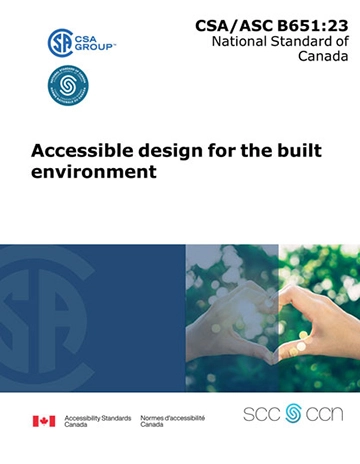Preface
This is the sixth edition of CSA/ASC B651, Accessible design for the built environment. It supersedes the previous editions published in 2018, 2012, and 2004 under the same title; the 1995 and 1990 editions published under the title Barrier-free design; and B651HB-18, Accessible design for the built environment — Implementation handbook.
The Technical Committee on Accessibility has produced related Standards including CSA/ASC B651.2, Accessible design for self-service interactive devices.
The Technical Committee has also developed other Standards including
a) CSA B480, Customer service standard for people with disabilities;
b) CSA B659, Inclusive design for an aging population; and
c) CAN/CSA-ISO IWA 18, Framework for integrated community-based life-long health and care services in aged societies.
The following are major changes to this edition:
a) dimensions have been updated based on current data from anthropometric research;
b) commentary has been included to assist in the interpretation of standard requirements;
c) Clause 4.2 has been added to provide a detailed explanation of luminance (colour) contrast;
d) the addition of revised guidance regarding luminance (colour) contrast throughout the Standard;
e) the addition of revised guidance regarding tactile direction indicator positioning to Clause 4.4.5.4.3;
f) Clause 4.7.1 has been updated to include detailed guidance on addressing functional and cognitive barriers;
g) Figure 12 a)has been updated to include both the original and updated versions of the ISO International Pictogram of Access;
h) information regarding T-turns has been added to Clause 5.1;
i) Clause 5.2.9.3has been updated with revised guidance for controls for power-assisted doors;
j) guidance regarding the minimum platform size for platform lifts that form part of an accessible path of travel has been added to Clause 5.6.2;
k) revisions to Clause 6.1have been made to include recommendations regarding water bottle filling and revised guidance regarding water fountain controls; and
l) Clause 6.6.1has been updated to address emerging adaptive technologies.
This Standard was prepared by the Subcommittee on Accessibility for the Built Environment, under the jurisdiction of the Technical Committee on Accessibility and the Strategic Steering Committee on Health and Well-Being, and has been formally approved by the Technical Committee.
The technical requirements in this Standard are minimum levels. They represent a consensus of the Technical Committee members, who represent a broad spectrum of interests. The members were helped and encouraged by the public comments received as a result of the wide distribution of a draft at the public review stage.
This Standard has been developed in compliance with Standards Council of Canada requirements for National Standards of Canada. It has been published as a National Standard of Canada by CSA Group.
Scope
1.1 Purpose
This Standard specifies technical requirements on how to make buildings and the exterior built environment accessible and safe for those with physical, sensory, or cognitive disabilities.
Notes:
1) Temporary buildings and facilities provided for public use should also comply with the technical requirements of this Standard. Such temporary facilities can include teaching spaces, reviewing stands, exhibit areas, bleachers, first aid facilities, and pedestrian passageways around construction sites, as well as temporary accommodations such as shelters.
2) Where public access is permitted during construction, renovation, or maintenance of a facility or an exterior environment, the requirements of this Standard should be respected to provide safe and equitable use for everyone.
3) Some people with disabilities could have requirements beyond the levels addressed in this Standard.
1.2 Application
This Standard describes technical requirements that can be used in the design and construction of new facilities or exterior environments, or in modifications to existing facilities or exterior environments. This Standard does not address the application of the technical requirements. The extent to which these requirements are to be applied is the responsibility of other AHJs.
1.3 Dimensions
The values given in SI units are the units of record for the purposes of this Standard. The values given in parentheses are for information and comparison only.
This Standard contains minimum requirements based on adult dimensions. Where converted from non-SI units, values have been rounded off with respect to critical dimensions.
All dimensions in figures are given in millimetres (mm) and are measured to the centreline, unless otherwise specified.
Notes:
1) When designing for specific individuals, their particular abilities and preferences should be taken into account. For example, some people prefer to transfer to or from a wheeled mobility device towards their preferred side when using toilet facilities.
2) If a facility is primarily to serve children, dimensions and other provisions should be adjusted to make them suitable for children.
1.4 Notes and figures
Notes and figures are included for explanatory or illustrative purposes only and are not a mandatory part of the Standard.
Figures are not to scale. If there is any difference between the text and a figure (where provided), the text shall take precedence.
1.5 Annexes
Annexes A to C provide additional information on topics considered in the Standard.
Annex D provides guidance for the design of outdoor trails and beach access routes.
Annex E contains references for accessible outdoor recreational environments to supplement the information and guidance provided in Annex D.
1.6 Terminology
In this Standard, shall is used to express a requirement, i.e., a provision that the user is obliged to satisfy in order to comply with the Standard; should is used to express a recommendation or that which is advised but not required; and may is used to express an option or that which is permissible within the limits of the Standard.
Commentary accompanying clauses do not include requirements or alternative requirements; the purpose of a commentary accompanying a clause is to separate explanatory or informative material.
Text accompanying tables is considered part of the table and may be written as a requirement.
Annexes are designated normative (mandatory) or informative (non-mandatory) to define their application.
1.7 Large print
Consistent with the recommendations of the CSA/ASC B651 series of Standards and for ease of reading, this Standard has been printed in a 14 pt font size.


